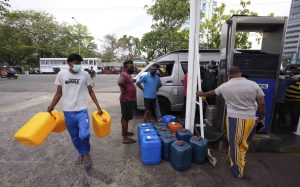In his television address to the nation on Monday night, Sri Lanka’s Prime Minister Mahinda Rajapaksa called on protestors to end their anti-government agitation. Every second of their protest is costing the country “vital dollars” he said.
Mahinda’s appeal is unlikely to restore calm on the streets of Colombo, where thousands of people have been gathering to press for his resignation and that of his younger brother, President Gotabaya Rajapaksa.
Gotabaya “will not resign from his post under any circumstances,” Chief Government Whip Johnston Fernando told parliament on April 6.
Neither the economic crisis nor the political impasse in Sri Lanka is easing. A week after Gotabaya imposed a state of emergency to quell protests against his rule and then revoked it upon realizing that the move was only galvanizing his opponents, exit routes to the multiple crises gripping the island appear to be running into dead-ends.
Shortage of essential commodities continues and could well worsen later this month. Sri Lanka could run out of diesel by the end of April as the $500 million line of credit that India extended for purchase of fuel will be exhausted in a little over a week from now. Unless this arrangement is extended or Colombo is able to source fuel elsewhere on credit, transport and fuel-dependent work on the island will grind to a halt. Hospitals are running out of medicines, medical equipment and consumables. The Perinatal Society of Sri Lanka has described the shortage as “extremely critical” and warned of a “catastrophic number of deaths.”
Amid this dire situation, Mahinda’s call on Monday to protestors to “have patience” seems insensitive. It will fuel public rage against the Rajapaksas.
Efforts to oust the Rajapaksas are gathering steam on the streets and inside parliament. Neither route will be easy.
In an article published in The Diplomat yesterday, Colombo-based journalist Rathindra Kuruwita drew attention to the leaderless protests being “a patchwork of people with different and even contradictory policy objectives.”
How effective would such protests be in toppling the Rajapaksas?
The protests would be vulnerable to division. Besides, since the Rajapaksas are unlikely to exit easily, the protests would need to be protracted. Do they have the energy to press on for months?
Should the mass protests pose a serious threat to the Rajapaksas’ hold on power, they will use violence to crush the protests. Neither Gotabaya nor Mahinda are averse to using violence against civilians. It was when Mahinda was president and Gotabaya defense secretary that unprecedented violence, including aerial bombing of civilians and hospitals was used in the final stages of the war against the LTTE. Since becoming president, Gotabaya, who served in the Sri Lankan Army for 20 years, has militarized the administration and relied on retired and serving generals for policy making and implementation. He would not hesitate to deploy the military now if it is needed to end the protests to his rule.
An unstructured and leaderless protest may not survive the Rajapaksa government’s highly likely use of violence to crush it.
Meanwhile, opposition political parties are strategizing to remove the Rajapaksa brothers.
Last week, Sajith Premadasa, leader of Sri Lanka’s main opposition party, the Samagi Jana Balawegaya (SJB) announced that he planned to move a no-confidence motion against the government and an impeachment motion against the President if he did not step down.
However, the opposition needs a simple majority i.e. the support of at least 113 legislators in the 225-seat parliament for the no-confidence motion to succeed. The SJB has 54 seats only in parliament. The Tamil National Alliance with 10 seats and the Janata Vimukti Peramuna with 3 seats have said they will back the no-confidence vote. But their support will not be enough. The opposition would need to get on board the 42 legislators who quit the Sri Lanka Podujana Party (SLPP)-led ruling coalition last week. So far they have not joined the opposition and have declared themselves to be “independents.” Some of them have said they will not support the no-confidence motion.
Impeaching the president is not only more difficult but also it is a long process. The Supreme Court is required to conduct an inquiry into the grounds on which the impeachment motion was moved. If the apex court finds that the allegations are indeed true, its report is then put before parliament and only then is the impeachment voted on. A two-thirds majority in parliament is required to impeach a president.
Winning a no-confidence vote is easier than impeaching the president. But what after the opposition has ousted the government? Is it in a position to form the new government? Does it have the numbers or the unity to do so? Importantly, Sri Lanka has an executive presidential form of government where the president holds massive powers. Would President Gotabaya allow a government headed by an opposition leader to function?
It is for this reason that the opposition is calling for abolishing the executive presidency.
Last week, after the Cabinet resigned en masse the president reached out to opposition parties to form a unity government. They rejected his offer. Gotabaya then appointed four ministers to keep the government running until he has a full cabinet.
Some Sri Lankans see fresh elections as the way out of the political impasse. But the constitution does not provide for a mid-term presidential election. A general election is possible now if parliament votes in favor of its dissolution. However, political parties across the board are opposed to this option as the country cannot afford an election at present.
The Sinhala and Tamil New Year is celebrated annually on April 13 and 14. This year Sri Lankans will have neither reason nor means to engage in feasts or festivities.
Heightened protest rallies are expected in Colombo.

































